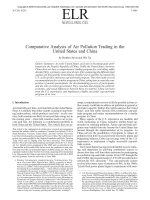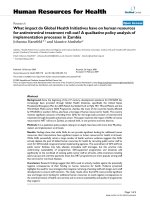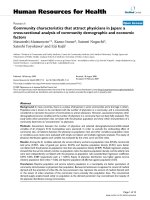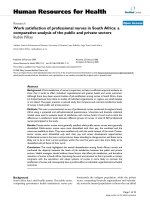A comprehensive comparative analysis of machine learning models for predicting heating and cooling loads
Bạn đang xem bản rút gọn của tài liệu. Xem và tải ngay bản đầy đủ của tài liệu tại đây (373.11 KB, 6 trang )
Uncertain Supply Chain Management 8 (2020) 563–568
Contents lists available at GrowingScience
Uncertain Supply Chain Management
homepage: www.GrowingScience.com/uscm
How does corporate performance affect supply chain finance? Evidence from logistics sector
Toan Ngoc Buia*
a
Faculty of Finance and Banking, Industrial University of Ho Chi Minh City (IUH), Vietnam
CHRONICLE
Article history:
Received November 29, 2019
Received in revised format
February 20, 2020
Accepted February 22 2020
Available online
February 22 2020
Keywords:
Cash conversion cycle
Corporate performance
Logistics sector
Supply chain finance
Vietnam
ABSTRACT
The paper investigates the impact of corporate performance on supply chain finance with the
data collected from logistics sector in Vietnam. Particularly, supply chain finance is measured
by cash conversion cycle (CCC). By using the generalized method of moment (GMM), the
results show that corporate performance (CP) exerts a negative impact on cash conversion
cycle (CCC). Alternatively, corporate performance positively affects supply chain finance,
which is an interesting finding of this paper. Further, supply chain finance is also significantly
influenced by some control variables, namely capital structure (CS), firm size (FS) and firm
growth (FG). The results are essential for the management of supply chain, especially those
working in logistics sector.
© 2020 by the authors; license Growing Science, Canada.
1. Introduction
After further integration to the global economy, Vietnam has been signing a number of free trade
agreements with some countries and areas. Among them, Comprehensive and Progressive Agreement
for Trans-Pacific Partnership (CPTPP) signed in Chile on March 8, 2018 should be highlighted. Thanks
to this, goods originated from different countries have been able to enter Vietnam’s market. Also,
Vietnamese products are more exported to other markets. Together with this, demands in logistics
services have significantly increased, which requires logistics companies to develop continuously as
well as improve their competitive capacity in order to meet their customers’ needs, thereby greatly
contributing in supporting the import and export activities locally. As a characteristics of logistics
sector, it is hard for an individual firm to perform all steps in delivery, so it is vital for logistics firms
to corporate in a supply chain. Especially in Vietnam, where most of the firms are small and mediumsized, this participation in supply chain becomes more necessary. Indeed, in the current time, there is
an intense competition between not only enterprises but also supply chains (Deng & Sen, 2017). In
supply chain management, the improvements in supply chain finance is a target which most firms aim
to (Marak & Pillai, 2019). It is because supply chain finance is an important element in supply chain,
allowing the firms to optimize their working capital (Raghavan & Mishra, 2011), raise their capital
access (Marak & Pillai, 2019), and more notably, optimize their financial flows (Pfohl & Gomm, 2009).
Beside supply chain finance, corporate performance is paid a lot attention by the managers when being
* Corresponding author
E-mail address: (T.N. Bui)
© 2020 by the authors; licensee Growing Science.
doi: 10.5267/j.uscm.2020.2.007
564
the goal of the firm as well as a foundation for their developments in the future. More than that,
corporate performance allows firms to raise their financial resources (either from remaining profit or
by external financing) which then greatly contributes towards the improvements in the performance of
the whole supply chain finance. These are just our subjective inferences. In fact, there is a limited
number of empirical studies analyzing the impact of corporate performance on supply chain finance.
This paper is carried out with the expectation to fill the current literature. Moreover, the results are
expected to give first empirical evidence in logistics. Hence, the results are essential for the
management in the improvements of supply chain finance.
2. Literature review
Logistics is a commercial activity which includes the implementation of one or complex operation,
involving receiving goods, transportation, storage, customs procedures, packaging, coding, delivery, or
other goods-related services as required by a customer. Regarding supply chain finance, it was first
considered in empirical research in the early 21st century (Pfohl & Gomm, 2009; Marak & Pillai, 2019)
which highlighted its role in the enterprises. In fact, supply chain finance allows the optimization in
working capital of its participants (Bui, 2020c). Further, it speeds cash conversion rate up and
stimulates financial link among its participants (Wuttke et al., 2013). More specially, it helps stabilize
the supply chain (Bui, 2020c). Therefore, supply chain finance is an essential key in supply chain
management (Farris & Hutchison, 2002). About the measurement, cash conversion cycle (CCC)
(Chang, 2018; Zhang et al., 2019, Bui, 2020c; Doan & Bui, 2020) which is defined as the period starting
from the cash outlay to cash recovery is frequently adopted as a proxy for supply chain finance. To
shorten CCC means that the time for cash recovery becomes shorter and companies can increase their
working capital, which in turn shows the good performance of supply chain finance. In other words, a
short cash conversion cycle reflects that supply chain finance performs well and vice versa. Corporate
performance of its participants plays a key role in boosting this performance. Its importance has been
explored in analyses of Wang (2002), Chiou et al. (2006), Bates et al. (2009), and Baños-Caballero et
al. (2010). Accordingly, corporate performance enhances financial resources of the participants,
thereby probably shortening cash conversion cycle (CCC) which means that supply chain finance
performs better. In another study, Caniato et al. (2016) reported that corporate financial strength are
vital for the improvements in supply chain finance. Thus, there have been a few studies mentioning the
role of corporate performance in supply chain finance and most of them have devoted little attention
on the detailed influence of corporate performance in supply chain finance, which is a gap in the current
literature. Hence, this is an interesting and necessary topic, most notably, for logistics enterprises.
3. Methodology
We adopt data of 32 logistics firms in Vietnam in the 2014-2018 period. Due to the fact that logistics
sector in Vietnam is quite nascent, a large majority are small and medium-sized firms. We estimate the
model by adopting panel data regressions which are Pooled regression (Pooled OLS), Fixed effects
model (FEM) and Random effects model (REM). Also, F and Hausman tests are employed to select
the most appropriate model among the three models. Then, we conduct hypothesis testing in regression
analysis, including multicollinearity, heteroscedasticity and autocorrelation. If the assumptions are
violated, the authors will adopt the generalized method of moment estimation to fix rejected hypotheses
and obtain the optimal results, following what Doytch and Uctum (2011), Bui (2020a), Bui (2020b),
Bui (2020c), Doan and Bui (2020) have performed. Moreover, the GMM has its superiority in analyzing
movements of financial determinants (Driffill et al., 1998). Following the previous scholars, we adopt
cash conversion cycle (CCC) as a proxy for supply chain finance. A short cash conversion cycle (CCC)
means a good performance of supply chain finance and vice versa. Corporate performance (CP) is
measured by ROA ratio (net income / total assets). Beside, based on the actual context in Vietnam and
what have been found by Caniato et al. (2016), Chang (2018), some control variables are adopted as
indicators of firm characteristics, including capital structure (CS), firm size (FS), and firm growth (FG).
T.N. Bui /Uncertain Supply Chain Management 8 (2020)
565
Therefore, the research model is proposed with the following equation:
CCC = f (CP, CS, FS, FG)
or:
CCCit = β0 + β1 CPit + β2 CSit + β3 FSit + β4 FGit + εit
Source: Proposed by the authors.
Fig. 1. Suggested research model
where:
Dependent variable: Cash conversion cycle (CCC).
Independent variable: Corporate performance (CP).
Control variables: Capital structure (CS), firm size (FS), and firm growth (FG).
The symbols β1, β2, β3, and β4 are regression coefficients, while β0 is a regression constant.
The symbol ε is the model error term.
Table 1
Summary of variables
Variable name
Code
Cash conversion cycle
CCC
Corporate performance
CP
Capital Structure
Firm size
Firm growth
CS
FS
FG
Measurement
Dependent variable
Logarithm of cash conversion cycle
Independent variable
Net income / Total assets
Control variables
Total debt / Total assets
Logarithm of total assets
(Salest - Salest-1) / Salest-1
Note: Cash conversion cycle (CCC) = Days receivable + Days inventories - Days payable = (trade receivable / sales) × 365 + (total inventories / cost of
goods sold) × 365 - (trades payable / cost of goods sold) × 365.
Source: Computed by the authors.
4. Results
The correlation among variables are shown in Table 2, which reveals that the independent and control
variables are negatively associated with cash conversion cycle (CCC). Next, the Pooled Regression
model (Pooled OLS), Fixed effects model (FEM) and Random effects model (REM) are adopted to
estimate the model.
Table 2
Variable correlations
CCC
CP
CS
FS
FG
Source: Computed by the authors.
CCC
1.000
-0.181
-0.185
-0.120
-0.041
CP
CS
FS
FG
1.000
-0.187
0.196
0.008
1.000
0.065
-0.104
1.000
-0.084
1.000
566
Table 3
Regression results
CCC
Pooled Regression model
Constant
Corporate performance (CP)
Capital Structure (CS)
Firm size (FS)
Firm growth (FG)
R-squared
Significance level
F test
Hausman test
Coef.
P>|z|
0.000
***
Fixed effects model
Coef.
***
P>|z|
0.000
Random effects model
Coef.
***
P>|z|
0.000
9.721
27.268
23.662
***
***
-0.048
0.009
-0.035
0.001
-0.040***
0.000
-0.015***
0.005
0.009
0.118
0.004
0.454
0.375
-0.789***
0.000
-0.641***
0.000
-0.072
-0.001
0.376
-0.001**
0.037
-0.001**
0.042
9.11%
56.88%
56.21%
F(4, 155) = 3.88
F(4, 124) = 40.89
Wald chi2(4) = 119.55
Prob > F = 0.005***
Prob > F = 0.000***
Prob > chi2 = 0.000***
***
F(31, 124) = 21.24 Prob > F = 0.000
chi2(4) = 159.47 Prob > chi2 = 0.000***
Note: ** and *** indicate significance at the 5% and 1% level, respectively.
Source: Computed by the authors.
Table 3 shows the estimated results using the basic panel data regression analyses, including Pooled
Regression model (Pooled OLS), Fixed effects model (FEM) and Random effects model (REM).
Accordingly, the Fixed effects model (FEM) is superior when the F-test is significant at the 1% level
(F(31, 124) = 21.24) and Hausman test shows 1% level of significance (chi2(4) = 159.47).
Consequently, the Fixed effects model is chosen for the estimation.
Table 4
Results of tests on multicollinearity, heteroscedasticity and autocorrelation
Multicollinearity test
Variable
Corporate performance (CP)
Capital Structure (CS)
Firm size (FS)
Firm growth (FG)
Mean VIF = 1.05
VIF
1.09
1.06
1.06
1.02
Modified Wald test
Wooldridge test
chi2 (32) = 21,057.02
Prob > chi2 = 0.000***
F(1, 31) = 18.539
Prob > F = 0.000***
Note: *** indicates significance at the 1% level.
Source: Computed by the authors.
Table 4 demonstrates the results of testing the assumptions including multicollinearity,
heteroscedasticity and autocorrelation by using VIF, Modified Wald test and Wooldridge test,
respectively. The results indicate that there are no serious issues of multicollinearity (Mean VIF < 10).
However, heteroscedasticity and autocorrelation really exist at the 1%. Thus, the authors choose the
generalized method of moment (GMM) for the analysis in order to avoid heteroscedasticity and
autocorrelation issues. Also, GMM can allow the authors to address potential endogeneity (Doytch &
Uctum, 2011).
Table 5
GMM estimation results
CCC
Constant
Corporate performance (CP)
Capital Structure (CS)
Firm size (FS)
Firm growth (FG)
Significance level
Number of instruments
Number of groups
Arellano-Bond test for AR(1) in first differences
Arellano-Bond test for AR(2) in first differences
Sargan test
Note: ** and *** indicate significance at the 5% and 1% level, respectively.
Source: Computed by the authors.
Coef.
P>|z|
12.578***
0.000
-0.169***
0.006
-0.022***
0.000
-0.154***
0.008
-0.001***
0.004
Wald chi2(3) = 63.18 Prob > chi2 = 0.000***
10
32
z = -2.13 Pr > z = 0.034**
z = -0.81 Pr > z = 0.417
chi2(5) = 7.66 Prob > chi2 = 0.176
T.N. Bui /Uncertain Supply Chain Management 8 (2020)
567
Table 5 shows that results of GMM estimator is appropriate at the 1% level of significance. Also, both
Sargan test and Arellano-Bond test for AR(2) in first differences are suitable. It can thus be concluded
that he results are valid. The results reveal that cash conversion cycle (CCC) is negatively (β = -0.169)
influenced by corporate performance (CP) at the 1% significance level. Further, the results confirm that
cash conversion cycle (CCC) suffers from a negative impact by the control variables which are capital
structure (CS), firm size (FS), and firm growth (FG) at the 1% level of significance.
Source: Computed by the authors.
Figure 2. Results of the research model
Thus, corporate performance (CP) exerts a negative impact on cash conversion cycle (CCC).
Alternatively, corporate performance (CP) is essential in stimulating supply chain finance, enhancing
financial links among the participants. This fits the characteristics of logistics sector when the
improvements in corporate performance facilitate the expansion of external financial resources (either
from remaining profit or by external financing), which aims a better supply chain finance. This is also
in line with what have been found by Caniato et al. (2016). Nevertheless, this is first empirical evidence
found in logistics sector. Therefore, this is meaningful for managers in supply chain, especially those
working in logistics sector.
5. Conclusion
The paper greatly succeeds in achieving its objectives by giving first empirical evidence on the causal
relationship between corporate performance and supply chain finance in logistics sector of Vietnam.
The results confirm the negative impact of corporate performance on cash conversion cycle. In other
words, corporate performance exerts a positive influence on supply chain finance. Thus, corporate
performance plays a key role in improving logistics firms’ financial resources, enhancing financial link
among the participants and, more importantly, boosting a better performance of supply chain finance.
Therefore, it is necessary for logistics’ supply chain finance to propose practical solutions for enhancing
corporate performance of its participants. Also, to attract more participants, especially those with great
financial potential, is a need. These will help supply chain finance perform more efficiently. Despite
its success, the paper has its limitations when not considering some macroeconomic control variables
which may influence supply chain finance, namely economic growth, inflation, exchange rates. Further,
as another limitation, the samples obtained are relatively limited due to the fact of a nascent Vietnam’s
logistics sector.
568
References
Baños-Caballero, S., García-Teruel, P.J., & Martínez-Solano, P. (2010). Working capital management
in SMEs. Accounting and Finance, 50, 511-527.
Bates, T.W., Kahle, K.M., & Stulz, R.M. (2009). Why do U.S. firms hold so much more cash than they
used to?. Journal of Finance, 64, 1985-2021.
Bui, T.N. (2020a). Domestic credit and economic growth in ASEAN countries: A nonlinear approach.
International Transaction Journal of Engineering, Management, & Applied Sciences &
Technologies, 11(2), 1-9.
Bui, T.N. (2020b). How does financial development affect the employment? Evidence from ASEAN
Countries. Journal of Management Information and Decision Sciences, 23(1), 1-6.
Bui, T.N. (2020c). Supply chain finance, financial development and profitability of real estate firms in
Vietnam. Uncertain Supply Chain Management, 8(1), 21-26.
Caniato, F., Gelsomino, L.M., Perego, A., & Ronchi, S. (2016). Does finance solve the supply chain
financing problem?. Supply Chain Management, 21(5), 534-549.
Chang, C.C. (2018). Cash conversion cycle and corporate performance: Global evidence. International
Review of Economics and Finance, 56, 568-581.
Chiou, J.R., Cheng, L., & Wu, H.W. (2006). The determinants of working capital management. Journal
of American Academy of Business, 10, 149-155
Deng, A., & Sen, M. (2017). A research review on pricing influencing factors of supply chain financial
services. World Journal of Research and Review, 4(2), 9-15.
Doan, T.T.T., & Bui, T.N. (2020). Nonlinear impact of supply chain finance on the performance of
seafood firms: A case study from Vietnam. Uncertain Supply Chain Management, 8(2), 267-272.
Doytch, N., & Uctum, M. (2011). Does the worldwide shift of FDI from manufacturing to services
accelerate economic growth? A GMM estimation study. Journal of International Money and
Finance, 30(3), 410-427.
Driffill, J., Psaradakis, Z., & Sola, M. (1998). Testing the expectations hypothesis of the term structure
using instrumental variables. International Journal of Finance and Economics, 3(4), 321-325.
Farris, M.T, & Hutchison, P.D. (2002). Cash-to-Cash: the new supply chain management metric.
International Journal of Physical Distribution & Logistics Management, 32(4), 288-298.
Marak, Z.R., & Pillai, D. (2019). Factors, outcome, and the solutions of supply chain finance: Review
and the future directions. Journal of Risk and Financial Management, 12(3), 1-23.
Pfohl, H.C., & Gomm, M. (2009). Supply chain finance: optimizing financial flows in supply chains.
Logistics Research, 1(3), 149-161.
Raghavan, N.S., & Mishra, V.K. (2011). Short-term financing in a cash-constrained supply chain.
International Journal of Production Economics, 134(2), 407-412.
Wang, Y. (2002). Liquidity management, operating performance, and corporate value: Evidence from
Japan and Taiwan. Journal of Multinational Financial Management, 12, 159-169.
Wuttke, D.A., Blome, C., Foerstl, K., & Henke, M. (2013). Managing the innovation adoption of supply
chain finance – empirical evidence from six European case studies. Journal of Business Logistics,
34(2), 148-166.
Zhang, T., Zhang, C.Y., & Pei, Q. (2019). Misconception of Providing Supply Chain Finance: Its
Stabilising Role. International Journal of Production Economics, 213, 175-184.
© 2020 by the authors; licensee Growing Science, Canada. This is an open access
article distributed under the terms and conditions of the Creative Commons Attribution
(CC-BY) license ( />









